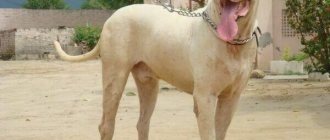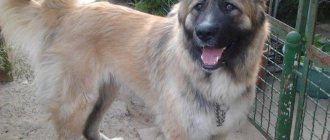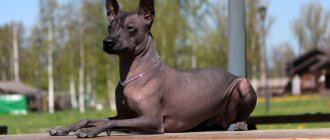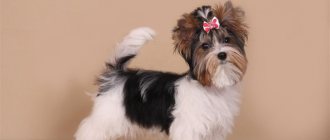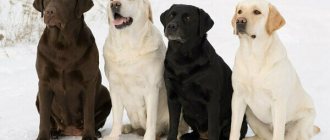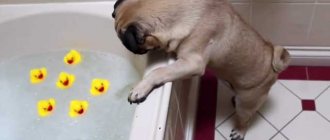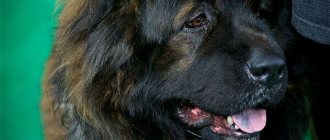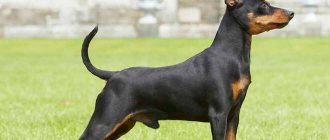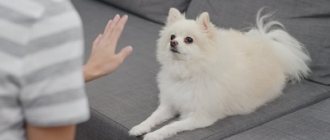The Medium (Klein Poodles) or by international standards the Small Poodle is the most popular variety of Poodle.
In addition to this, the varieties of the breed include large or royal (Standard Poodles), dwarf, Teacup Poodles, miniature Poodles, and Toy Poodles.
Pets get along well with children and other pets.
They are affectionate, kind and have a unique character.
Origin story and what it looks like in the photo
Images of a curly dog, very similar to a modern poodle, are found on ancient frescoes, Greek and Roman coins.
Initially, the breed was formed as a hunting breed, but in the 19th century, the medium poodle was increasingly used as a decorative lap dog and companion dog..
Among the ancestors of the poodle are barbets, Portuguese water dogs, truffle dogs, pointers, greyhounds, spaniels, retrievers, and Maltese.
Types of dogs (with photos and names)
There are several other types of poodles that vary depending on their coat and overall appearance.
shorn
Cropped poodles include representatives of all of the above types of poodles that have curly hair.
Such a coat is regularly trimmed, since when it grows strongly, the animal’s view is blocked and its appearance is far from the canons of canine beauty.
Uncut
Uncut poodles generally have a mane-like coat on their head.
Such animals are bred for home education, but uncut poodles are not allowed to participate in various exhibitions, since such an appearance is considered bad manners among breeders.
Corded
This type includes representatives of different types of poodles with a corded type of coat. The tourniquets look quite impressive, but require constant maintenance.
From puppyhood, the animal is regularly brushed and washed with soap and shampoo designed for coarse hair..
Moisture must be removed with a towel, without using a compressor or hair dryer.
For a beautiful appearance of the coat, it is necessary to sort out individual strands every week for 3-4 weeks, and after they grow back, untangle them at the base.
The final formation of cords is observed when the animal is 3-4 years old..
Cocker (cockapoo)
There are several varieties of cockapoo:
- dwarf – weight no more than 3 kg;
- toy – weight from 3.5 to 5 kg;
- miniature - weight about 9 kg, height at the withers ranges from 35 to 38 cm;
- Cockapoo is a standard that is practically no longer found; weight can reach 30 kg.
They have an attractive appearance, the coat is wavy or straight.
The animal gets along well with all family members, never conflicts with other pets and is ready to compromise if necessary . Pets are curious and optimistic, easily cheering up their owner.
Cockapoos are intellectually developed and easy to train.
Tikap
Tikap looks like a small toy dog.
Height at the withers is less than 25 cm, and average weight is about 2.5 kg.
The animal is bred by breeders, which provokes the likelihood of genetic diseases.
Description of the breed
There are several breed standards - German, English, American and French.
The French standard is adopted as the basis for the FCI standard used in Russia..
The latest edition of the official FCI standard came into force in 2015. All standards are the same for all varieties of the breed and differ only in size characteristics.
Main characteristics of the breed according to FCI:
- Group, purpose, test - 9. Companion dogs without tests.
- The general impression is that of a slender, harmoniously built, elegant dog with a sense of self-esteem. The proportions are average.
- The head is light, but without excessive refinement, refined lines, and is proportional in size to the body.
- The skull is slightly elongated, oval in shape.
- The forehead is rounded, with a longitudinal dividing groove, slightly narrowing from the ears to the muzzle.
- The muzzle is slightly shorter than the skull with a rectangular, non-pointed facial part.
- The nose is large with a flat back, rounded wide and open nostrils. The lobe is dark, depending on the color, from light chocolate to black.
- The eyes are almond-shaped, expressive, intelligent, slightly slanted. Dark brown or black.
- Ears with rounded ends, hanging down to the point where the lips close.
- The lips are dry, of medium width, adjacent to the jaw. The upper lip hangs over the lower lip.
- Scissor bite.
- The teeth are strong and white.
- The length of the neck is almost equal to the length of the head. The neck is strong, with a clearly visible bend, without folds. The head position is high.
- The body is slightly elongated and strong.
- The back is wide, short, straight.
- The chest is wide, deep to the elbows, the keel bone protrudes slightly beyond the line of the torso. The ribs are oval.
- The loin is strong and muscular.
- The croup is rounded, but not sloping.
- The groin is toned, but without “undermining”.
- The tail is set high, carried high and slightly slanted. The tail is left natural, but can be docked by half or a third.
- The limbs are straight, developed, flexible, parallel, with strong joints.
- The foot is not large, but strong.
- The fingers are curved, compactly collected, and webbed. Dewclaws are removed. The claws are dark brown or black.
- The coat is thick, elastic, without a specific odor, curly or corded.
- Movements are free, graceful, springy.
The name "poodle" comes from the German "pudeln" - to splash in the water, which indicates the original hunting purpose of the breed.
History of the breed
The poodle is distinguished by its refined, aristocratic demeanor; it is a proud dog that knows its worth. Representatives of the breed were and are pets of famous writers, artists and even royalty.
This is a very ancient type of dog, its origin has not yet been precisely established and even the country that is the birthplace of the poodle is unknown. There are two versions about this:
1. If you believe the first version, the homeland of the poodle is France. The French used poodles as gun dogs for hunting. 2. According to another version, poodles originated from Germany.
The first images of animals similar to poodles were discovered in Rome in tombs, as well as on bas-reliefs and ancient coins. In the twelfth century, images of poodles decorate cathedrals and castles in France. The sixteenth century brought the breed great popularity in European countries, and then practically throughout the World. In the nineteenth and twentieth centuries, the first breed standards were established.
Exactly translated, “poodle” means “splash in the water.” This name was not given in vain, the poodle loves water very much; when it reaches a pond, the dog will splash around there for an hour or two... In France, these dogs are considered national pride. There are many varieties of the breed. For example, the standard or large poodle was used primarily for hunting waterfowl. The purpose of the toy poodle is to be a companion.
Also, representatives of this breed, thanks to their excellent sense of smell and developed intelligence, were and are in search and rescue services. The poodle has also established itself as a customs dog. At any position, such a dog works with complete dedication.
Character traits
The character of medium poodles is unique.
Dogs:
- smart, curious;
- active, playful, love to participate in exhibitions, receptive to praise;
- affectionate, sociable, feel the owner;
- efficient, hardy, passionate.
The author of the book “Dog Intelligence”, Dr. Stanley Coren, gave poodles second place in intelligence and trainability after the border collie.
Expert opinion
Kozhevin Semyon Kirillovich
Expert dog handler.
The medium (small) poodle is a small, curly-haired miracle, energetic and graceful, able and loving to enter the ring. These are dogs with a stable psyche and a pronounced show temperament. They have self-esteem and are not cowardly. Not prone to empty talk.
Care and maintenance
Poodles move around a lot during the day. These are very energetic creatures that need long walks. You can live with them not only in a house, but also in an apartment, the main thing is to go out into the fresh air more often. The ideal option for relaxing with such a pet is in nature. He loves to run in the forest, especially when the weather is sunny, swim in water, but not deep, bring a ball to the owner, etc.
Therefore, when going on an outing with friends, do not forget to take your dog with you! You will have to bathe your fluffy dog often. Fortunately, he enjoys this procedure, so he does not resist when he finds himself in a full bathtub. When shampooing your animal, be careful not to let any water get into its ears.
Gently rinse his eyes. Lather each paw, making sure to thoroughly clean out any dirt between the pads. In addition to the main detergent, shampoo, we recommend using animal conditioner. At the end of the procedure, the dog should be thoroughly dried with a towel.
If you wash it in winter, especially in a cool apartment, it is better to dry it additionally with a hairdryer. Otherwise, he may catch a cold. After these manipulations, the dog should be combed with a comb. It is important to “walk” it all over her body, paying special attention to the area under the ears.
Important ! The Miniature Poodle is perfect for dog owners with allergies. It has hypoallergenic wool, which, moreover, does not shed at all.
If you notice that your dog's fur is coughing or matted, we recommend using a spray bottle to spray moisture on it and then combing it. Her fur grows very quickly, so she will have to resort to the services of a groomer often, every 3-4 weeks. We do not recommend cutting such an animal yourself.
Poodle ears require special care. They are washed out of sulfur very carefully so as not to injure the delicate skin near the canals. If excess moisture gets into the ears, inflammation cannot be avoided.
Advantages and disadvantages
Owners believe that dogs are full of virtues:
- obedient, understanding;
- artistic, talented, capable of imitation;
- universal in use (companion dogs, entertainers, guide dogs, orderlies, therapy dogs, athletes, search dogs);
- compact, easy to travel;
- They are not aggressive, but do an excellent job as a watchman.
The disadvantages of medium poodles include::
- tendency to dominate, stubbornness;
- difficulty in caring for hair;
- tendency to hereditary diseases and food allergies;
- unbearable loneliness;
- requirement of full physical activity.
Training and education
Training one of the smartest breeds in the world is not at all difficult. The poodle easily and quickly remembers commands, trying to fulfill them as best as possible, thereby pleasing the owner. The main thing is to carry out education and training consistently and calmly. You cannot interrupt the training course unless health problems require it.
Even an inexperienced poodle owner will feel like a skilled trainer during lessons with his pet. First, you can teach your puppy simple commands at home, then go through the basic training course lesson by lesson. After this, having decided what you want from your dog, proceed to more complex training. The poodle can be a skilled hunter, companion, circus and film performer, exhibition champion, and test dog.
Interesting Facts
- The poodle is an excellent swimmer and loves to swim.
- The poodle is in second place on the list of the most intelligent breeds.
- The poodle is able to adapt very quickly to any climatic conditions.
- Representatives of the breed are often featured in films, and they are also the main characters in books. Viewers can admire the poodle in the film “Without a Family.” A.I. Kuprin also wrote a wonderful story “White Poodle”, later a feature film was made based on it, the main character in it is a poodle named Arto.
- The poodle is rightly called the symbol of all decorative dogs.
- A poodle is a kind of living decoration, both on stage and in an ordinary room.
- Silver puppies are born with black fur. Only after two months the color changes from black to silver.
- Representatives of the breed served in the army of Napoleon Bonaparte. The poodle was approved as an integral part of the equipment of military officers. The dogs were supposed to look for wounded soldiers on the battlefield.
Color variations
The latest version of the standard describes 6 acceptable color variations of the breed:
- Black.
- White.
- Warm brown, dark brown. Undesirable variations: beige, light brown with a golden tint, chocolate, faded red.
- Gray (silver). The color should not be close to black or white.
- Apricot. It should be pure apricot, not bleached red or brown.
- Red (red). Shades of fawn, orange and red are possible.
Some national (Russia, Great Britain, Germany, Czech Republic, USA) breed standards recognize the colors harlequin and black and tan.
The color should be one color and uniform, without spots, marks, or overflows.
There are several colors not recognized by the standard:
- harlequin - black and white;
- brindle - a striped pattern on a background of any color;
- black and tan - black with markings of any shade;
- sable (burnt dough color) - dark brown topcoat with black or dark brown tips;
- silver beige - dogs are distinguished by amber eyes;
- coffee with milk - a combination of chocolate, apricot and cream;
- cream - shades of champagne color;
- blue and blue - gray (silver) with a blue tint;
- splash - white spots on any background, occupying less than 50% of the total body area;
- merle (marble) - light or dark inclusions on any background;
- two-color - spots are chaotically located on a white background, often black or brown.
Raising and socializing a dog
The poodle is a very artistic breed, so it is recommended to organize its training process like a circus performance. He is a born artist, so he needs spectators and encouragement. If you want to teach him simple commands, invite your household members to sit next to him and watch the process. Let them clap their hands every time the dog has completed the task. This is a great training method!
To teach such a pet complex acrobatic tricks as quickly as possible, walk him often. Yes, having gained new emotions and vivid impressions, he will try to earn approval. Don't forget that poodles are one of the smartest dogs that can be taught to do almost anything, for example, they can fetch slippers for their owners or carry their own leash.
By the way, about walking. Representatives of the breed love to walk in different places, and for quite a long time. But this does not mean that they can be indulged in everything. They should not pull on the leash. But, if this does happen, we recommend taking action. Pull your pets firmly and stop from time to time. This way they will quickly learn to understand that a person is in control of the walk.
Some tips for home socializing your toy poodle:
- Don't leave him alone, locked in a room. This dog doesn't like to be alone.
- Be there when he meets your other pets. The dog should understand that you are protecting him and, if something happens, will protect him.
- If another dog notices your pet while walking, pick it up.
Poodles have good health and are long-lived.
You should teach him as early as possible, firstly, to respond to a nickname, secondly, to go to the toilet on the street, and not in the house, and thirdly, to treat each family member with respect. Reprimand an animal if it barks for no reason, shows aggression towards anyone, or refuses to obey.
Attitude towards children and pets
The average poodle can safely be called a children's friend. He is easy-going and enjoys taking part in children's pranks.
He perceives strangers with caution, but, seeing the owner’s positive reaction, he can include guests in the “inner circle” of communication..
He strives to establish friendly relations with pets.
Poodle Grooming
Large apricot colored poodle
Toy poodle after haircut
For participation in exhibitions in FCI countries, the following haircut options are currently allowed: “Continental”, “Scandinavian Lion”, “Modern”, “English Lion”; for puppies - the first and second puppy (pappy clip). These haircuts are performed according to a standard, the nuances of which are, however, subject to the influence of fashion. Performing haircuts (grooming) is a rather labor-intensive process that requires special skills [ source not specified 1898 days
]. For dogs that do not participate in exhibitions, other, more practical haircuts are used.
How to properly care
Regular treatments required:
- Combing 3 times a week. In puppyhood - daily.
- Bathing with zoo shampoo (no more than 4 times a year) or without it when soiled and before exhibitions.
- Haircut, plucking every 2 months.
- Inspect the ears after each exit to the street, clean them at least once every 14 days.
- Eye examination by a veterinarian at least 2 times a year, wiping - weekly.
- Arrangement of the bed in a place protected from drafts.
- Trimming of nails as they grow, pedicure before going to the arena.
Health
On average, a poodle can live 13-17 years . With proper nutrition and care, a pet can become a long-liver and live up to 18-19 years . Representatives of this breed have weak points in their bodies; the owner should be aware of them. Poodles are predisposed to the following diseases:
- Urolithiasis – the essence of the disease is simple: the bladder fills with stones of different sizes, which block the urinary canals, causing unbearable pain.
- Epilepsy is a disease in which the functions of the brain are impaired. It usually manifests itself as seizures, convulsions, and excessive salivation.
- Legg-Calvé-Perthes syndrome is an aseptic necrosis of the head of the femur, most often occurring in toy poodles.
- Joint dysplasia – joints become deformed, lameness and severe pain occur.
- Dilated cardiomyopathy is an idiopathic disease characterized by poor myocardial contractility with (or without) arrhythmia.
- Von Willebrand disease is a hereditary disease characterized by blood clotting disorders and spontaneous bleeding.
- Skin diseases.
- Sebaceous adenitis is a pathology characterized by disruption and destruction of the sebaceous glands.
- Progressive retinal atrophy is a set of pathological processes with dystrophic degeneration of the retina.
- Patella luxation.
- Obesity.
- Ear diseases.
- Diabetes.
- A cleft of the hard palate is a congenital defect that is a tear or hole in the middle part of the palate.
- Gingivitis is partial or complete inflammation of the gums. It manifests itself as swelling and redness of the gums, which can lead to abscesses and tooth loss if not treated promptly.
The dog must be brought to the veterinary clinic at least once a year for preventive examinations. The owner must ensure that vaccination is carried out on time. It is also important to treat your pets for external parasites.
How long do they live? Major diseases
Medium poodles live 12-15 years.
Long-lived individuals have been known to live up to 18 years. Dogs are prone to a number of breed-specific diseases that can significantly shorten their life expectancy.
Among them:
- lymphadenitis;
- diabetes;
- von Willebrand disease;
- urolithiasis disease;
- insulinoma;
- epilepsy;
- indigestion, volvulus, bloating of the peritoneum;
- congenital deafness;
- pelvic-femoral dysplasia, bone fragility;
- otitis;
- retinal degeneration, glaucoma;
- cryptorchidism;
- overgrowth of the nasal passage;
- tartar;
- hypothyroidism
Sizes and weights of adult poodles:
| Variety | Height at withers | Weight |
| Average | 35-45 cm | 9-12 kg |
| Big | 48-58 cm | 20-23 kg |
| Miniature | 28-35 cm | 6-8 kg |
| Miniature, toy poodle | 25-28 cm | 4.5-5 kg |
The growth of a medium poodle puppy ends at 12 months.
What types exist
There are several varieties of poodle :
| Species name | Description |
| Standard | This type is also called large or royal. The height of such a poodle is 45-60 cm. It requires special conditions, a small apartment is not suitable, it needs to be walked frequently. The animal is easy to train and has service and hunting potential. Discreet and proud, he will never do anything dirty. |
| Small | They are also called medium. The height of such poodles is 35-45. In character they are very similar to royal ones. They are distinguished by endurance, obedience, and accuracy. They will easily take root in an apartment, but also need walks and physical activity. |
| Dwarf | The size is 28-35 cm. They are also hardy, despite their touching appearance. They are jealous and require increased attention. They are loyal to their owner, but love to play and do mischief with children. |
| Toy poodle | Resembles a toy, height - up to 28 cm. They have a vulnerable and vulnerable character, they are proud. They don’t like to be treated like a thing, they can bite. They bark constantly and demand the owner's attention. They are also distinguished by their loyal and devoted character. |
| T-cap | The smallest and rarest representative of the breed, whose height is on average 18-27 cm and weight does not exceed 4 kg. They are distinguished by their especially cute appearance, but at the same time they have very fragile health. |
Nutritional features. What is better and how to feed it correctly?
To feed a medium poodle, use ready-made food (preferably marked “For poodles” or “For dogs of medium breeds”), corresponding to the age of the dog and its lifestyle, premium or super premium class.
You can create a dog menu that also includes natural products.
It should include:
- raw or boiled lean meat (veal or beef);
- beef by-products;
- raw beef and veal bones;
- raw chicken eggs;
- fermented milk products without flavoring additives;
- rice and buckwheat porridge, cooked in broth or water;
- seaweed;
- raw and cooked seasonal vegetables and fruits;
- dried fruits, raisins.
Strictly prohibited:
- fatty meats;
- sweets, baked goods;
- herbs and spices;
- food that is too hot or cold;
- pickles, smoked meats;
- raw sea or river fish;
- sausages, brisket, lard.
NOTE!
The diet of each dog is compiled individually, based on its preferences, lifestyle and health status.
Puppies up to 2 months of age are fed 5-6 times a day. From 2 to 4 months - 5 times, from 4 to 7 - 3-4 times. At the age of 10 months, babies are transferred to an adult feeding regimen - 2-3 times a day.
Character and training
Poodle puppies begin to show their intellectual talents from a very early age. Having learned to walk, babies imitate their mother in everything, they can even try to follow commands. Having bought a 3-month-old pet, you may be surprised at the already firmly established habits. Before purchasing, ask the breeder in detail about the mother of the puppies, her schedule and habits, as you will most likely encounter the same skills in your own home.
Fortunately, Poodles have a very flexible personality and unlimited abilities. Even a poorly trained dog can be taught all the intricacies of “etiquette” and more. Despite its brilliant characteristics, raising a four-legged animal should not be trusted to a child under 12 years of age. Don’t take risks, if only because dogs have a very keen sense of smell and innate hunting skills. A child may not notice how a pet runs away after a bird or a mouse. A lost Poodle will look for a way home, but it may be interrupted by utilities, vehicles, flayers or dog hunters.
This is interesting! There are legends about the phenomenal sense of smell of Poodles, but there are also stories confirmed by facts. It was in Rome, on vacation, the owner of the Poodle went away for a few minutes, leaving his charge in the car. The vehicle was stolen and a terrible 84 hours began for the dog. It was at this time that Nika returned to the scene of the theft and fell exhausted on the threshold of the hospital. The doctors picked up the poor woman and began to provide her with all possible help, after calling the owner, who posted a notice on every pole in the area. The veterinarian later determined that the dog had been running for more than 40 hours. And even later, when the car and the intruders were found, it turned out that Nika swam across the Tiber and somehow climbed an almost vertical slope.
When studying the theoretical basis, training a Poodle at home will go without any difficulties. Moreover, you shouldn’t stop at basic commands, teach your ward tricks. Monotony is the worst enemy of training, even for a dog as smart as the Poodle. Teach your pet to bring you slippers, entrust him with some household chores, and maximally occupy your tailed’s leisure time with activities that are useful to you. There is no need to suffer from remorse; you are not exploiting the dog, but giving it the opportunity to express emotions and expend energy.
If you have free time, you can teach your Poodle agility, offense, freestyle, Frisbee tricks, fetching, diving or any other skills. Naturally, it is worth taking into account the preferences of a particular pet; one dog will be happy to look for toys, another will prefer to jump over obstacles. The main thing is that you and your pet enjoy the activity.
This is interesting! In 1985, a team of Poodles competed in sledding competitions. Out of 17 races, the original team finished first 5 times. After this “precedent”, Poodles began to be actively trained in agility and other “side” sports skills.
Poodles are quite flexible when it comes to children. Tailed ones who grew up with toddlers will never harm unfamiliar children and will avoid confrontations in every possible way. If the dog has never had contact with children, it is worth monitoring the formation of the relationship. The Poodle will not bite intentionally, but he may be afraid of a scream or snap in response to pain. The four-legged dogs are quite reserved towards strangers, but if the owner is in a positive mood, they quickly allow the stranger into the “family circle”. Dogs, cats and even birds living in the same territory as the Poodle are perceived as friends, although at first it is worth monitoring the establishment of mutual contact.
Types of haircuts
Only dogs with show haircuts are allowed into the ring.
There are several of them:
- English haircut . The back is trimmed to the line of the ribs, the croup, the front legs and the muzzle; round or oval pompoms, bracelets or constrictions are left on the tail and joints. The bangs are pinned up.
- A lion. The haircut is similar to the English one, but “pants” can be left on the front legs.
- Modern. Only the paws and muzzle are trimmed.
The appendix to the FCI standard describes another, conditionally acceptable haircut, as a preparatory stage for permitted haircuts - papi.
Distinctive features
Miniature poodles fit into the general standard of poodles and differ from other species only in size. They are considered a smaller version of the average breed, not as refined and weak as the Toy Poodle.
The latest standard was published in 2007. According to it, the mass of the Dwarf representative should not exceed 6 kg and be less than 4 kg . The height at the withers varies from 28 cm to 35 cm . All individuals with inappropriate characteristics are discarded.
- The head is not very refined. The brow ridges are well defined, the stop is faintly visible, represented by a smooth line.
- The muzzle is strong and wide, rounded at the end. Long (amounts to 9/10 of the skull). Cheekbones of medium volume. The skull is not filled in under the eyes. The teeth are quite strong, with a scissor bite The lips are well developed, the thickness is average, the color depends on the color of the coat - the darker the color, the darker the pigment.
- The nose is large with well-developed nostrils, slightly upturned. The color of the nose changes with the color of the coat: in white, black and gray poodles it is black, in apricot, red and brown poodles it is most often brown.
- The eyes are set at stop level, slightly slanted. Almond shaped. The color of the iris can be black or brown.
- The ears are wide at the base, long, thin, hanging down to the sides of the head.
- The body is strong and well built. The back is straight and strong, the croup is located at the same height as the withers. The loin is short and strong. The chest is well dropped (to the middle of the elbows), wide (2/3 of the depth), the ribs are rounded. The neck is of medium length, strong, and its cross-section forms an oval. The scruff is convex , there is no dewlap. The stomach is tucked.
- The tail is set high, carried upturned, and slightly inclined. Long enough, docking is possible.
- Limbs straight , parallel. The muscular system is well developed, the knee, elbow and hock joints are visible. The feet are small, compressed, with strong black or brown claws. Moves easily and springily.
- The coat can be curly or corded. In the first case, the coat should be thick with uniform fluffy springy curls. In the second - long corded curls (at least 20 cm).
- Color: gray, white, black, peach, red and brown (solid).
How to choose? Boy or girl?
Selection rules are standard:
- the nursery must have a good reputation;
- conditions for keeping puppies comply with standards;
- the puppy must have a full set of documents: pedigree, puppy passport with marks;
- A certificate of testing for genetic diseases is desirable;
- the puppy should look healthy, active, and moderately well-fed;
- The fur should be shiny, the eyes and ears should be clean, and there should be no discharge in the anal area.
Girls are considered more flexible and calm, boys are more active, energetic, and curious . But a dog's temperament sometimes manifests itself in a completely different way than expected.
Price
Only the breeder from the nursery will provide you with a guarantee that the dog fully complies with the accepted international standard. Therefore, if you would like to take your pet to show exhibitions in the future, be sure to purchase a pedigree for it.
The price of a miniature poodle with documents from the nursery is from 7 to 15 thousand rubles. Some breeders artificially inflate the cost of these dogs, selling them for more than 30 thousand rubles. We do not recommend working with them!
Poodle history
The modern poodle is the national breed of Parisians.
But the homeland of the curly-haired handsome man is northern Europe. Originally, he was a hunting dog, trained to retrieve game from the water and bring it to his owner. Translated from German, the name of the breed means splashing. No one can accurately determine the homeland of the poodle. 4 varieties of the breed make it difficult to trace the history of origin. The ancestors of the royal and standard poodles are considered to be the water spaniel and the truffle dog, in whose appearance the features of the commander and the bullet are visible.
The small and miniature poodles have the blood of Maltese, Bichons, and Toy Spaniels.
Images of a poodle-shaped dog were found on minted coins of Greece, bas-reliefs of ancient Roman burials, dated 4-5 centuries BC. e.
Descriptions of similar dogs are found in literature of the 12th-13th centuries. Later, in the paintings of Durer and Rembrandt, the poodle appears in its modern guise with a “lion’s haircut.”
In the 18th century, the breed became incredibly popular. On the battlefield, dogs search for the wounded and serve as guides. Nobles keep them as exotic pets.
The poodle dog received the greatest recognition from traveling artists. Thanks to its talents, the animal has become an indispensable attribute of performances.
Health and illness
Like any breed, the poodle is prone to certain diseases:
- Overgrowth of the nasal passage. The dog wheezes, snores, and has difficulty breathing. The problem is solved using surgical methods;
- heart diseases. Most often acquired. For prevention purposes, it is worth loading your pet as much as possible;
- epilepsy. Transmitted genetically. It is difficult to treat;
- double eyelashes. Expressed by eye discharge and inflammation. Excess hairs are removed surgically.
- tartar. It manifests itself as a smell from the mouth, a brownish coating on the surface of the enamel. Regular cleaning of the oral cavity will protect your pet from problems;
- like all lop-eared dogs, poodles are prone to otitis media;
- pancreatic diseases provoke diabetes. Manifested by increased thirst, weakness, and possible fainting.
Fortunately, most dogs are born healthy. Conscientious breeders do not allow individuals with pathologies to be bred.
Basic colors
There are a number of poodle colors that are designated by the Fédération Cynologique Internationale:
- White . Snow-white poodles are quite attractive and photogenic, but there are much more worries with an animal of this color than with all other representatives of this breed. This color option is only suitable for very clean people.
- Black . The most practical color option, since animals of this color get dirty more slowly and are quite attractive in appearance.
- Ginger . With age, the color becomes lighter. Skin color matches coat tone. The eyes are outlined in brown, the nose can be either black or brown. The eyes are brown.
- Chocolate . The coat is dark brown. The tips of the hair on the ears are lighter. The skin is identical to the tone of the coat. The lips and eyes are outlined in dark brown or black. The nose is liver colored. Eyes – rich brown or dark amber.
- Gray . A very complex color, the formation of which occurs over several years. Puppies are born black, but gradually the coat color changes. Upon reaching the age of 1.5 months, a silvery tint to the muzzle and paws can already be seen. To correctly determine the color, the animal can be shaved, then a silvery tint will be noticeable at the root. Skin tone matches coat color.
- Pink . The coat color is pale pink, matching the skin tone.
- Apricot . The wool comes in various shades of apricot, which are close to dark brown or white. The ears are slightly darker than the base color. Puppies are born with a darker color, but gradually the coat becomes lighter. Quite often this color transforms into cream. The skin is white or pink, may have gray-blue shades.
- Peach . The coat color is beige-pink. Skin tone is identical to coat color.
